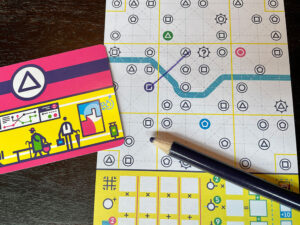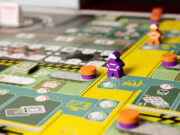 Weeks before the pandemic hit, I was plotting a course to visit the UK with London as a central destination. And while I’ve not had the opportunity to revisit these plans, the idea of getting out into the world and traveling internationally again has continued to enter my mind.
Weeks before the pandemic hit, I was plotting a course to visit the UK with London as a central destination. And while I’ve not had the opportunity to revisit these plans, the idea of getting out into the world and traveling internationally again has continued to enter my mind.
Next Station: London, published by Blue Orange Games and designed by Matthew Dunstan, is a flip-and-write game that tasks players with reimagining the London Underground. Even though I’ve not experienced the metro in this faraway city, I can now at least reimagine the zig and zag of multi-colored lines crossing through districts and passing under the Thames. It’s time for a little revisionist gameplay.
Gameplay Overview:
Next Station: London features a relatively simple ruleset and action design space. The game plays from one to four players in about twenty-five minutes. Each player is given a sheet featuring an abstract map of London with thirteen districts displayed as a grid. Within these grids are symbols that represent stations, as well as some that feature compass points to designate them as tourist destinations.

Four differently colored pencils are distributed amongst those playing and are passed to the next player after each round is complete. Each session finds a player utilizing all four colors to draw routes on the map related to the four metro lines. Stations can be visited by multiple colors, but routes cannot cross over a line that’s already been established. As such, it’s important not to box yourself in, as routes are drawn from the furthest edge of the track and only a special card can allow a junction to be placed.
How do these routes emerge you ask? Well, there are five pink cards with various station symbols, as well as six blue cards that feature various symbols and one junction. These are shuffled and drawn one by one, until a fifth pink card is drawn. As such, rounds with a specific-colored pencil may last from five to ten turns. Players draw a line from their starting station to an adjacent symbol that matches the drawn card. Thankfully there is a wild card of each color that assists in moments where you need a certain symbol to proceed.

End-of-round scoring is based on how many districts were visited multiplied by the largest number of stations you visited within a single district. Players add points for how many times their line crossed the Thames which flows through the central districts. Players also cross off how many tourist destinations they visited and for each crossed off it increases the possible points for this at the end of the game.
Each colored route proceeds in a similar fashion. Once all four routes are complete players also gain points for how many stations feature connecting routes of two, three, or four different lines. The game also comes with two additional modules that can be added either separately or together. One gives a random power to each colored pencil that can be used once per round. These powers stay with each pencil as they are passed each round. The other provides shared objectives for all players.

Game Experience:
Ultimately this is a multiplayer solitaire experience as players pass around pencils and puzzle out the best way to draw their current line to maximize points. Outside of the final comparison of scores, there’s not much here that provides an extroverted excitement. Yet, there’s something satisfying about the way that each player utilizes the same card draws for different lines and how a simple decision to draw a line in a certain direction can cause tension for the next draw.
The card draw mechanism here may be the best element. You never know how long a round is going to last, but with only ten cards of each color (the eleventh card being a junction option), players can easily press their luck by knowing which symbols are still in the draw pile. There’s been excitement at our table when a card draw doesn’t go our way, followed by a moment of silence in times where the draw prohibits a legal move thus necessitating a missed turn.

The other great thing about Next Station: London is the optimization puzzle. The design of scoring points based on building a route in multiple districts yet having that be multiplied by your largest number in a single district creates a unique tug of war with how to proceed. This, coupled with points for crossing the Thames, as well as the need to connect multiple colors to a single station, all add a lot of fun tension for such a short experience. It’s also worth mentioning that four of the districts are single stations on the corners of the map, so seeking them out pulls you further away from interchanges and the Thames.
The artwork by Maxime Morin is vibrant and playful. There isn’t much beyond the Thames representation on the maps though that relates to London. The sheet could truly be any city, and the people in the art feel like they are from a generic business graphic design project. As such, the theme certainly relates to the breezy flip-and-write, if not quite inspired, and you can see where if successful this could spawn additional Next Station games for different cities.
It’s a shame that this game didn’t come with different maps to try. The variability would be a nice addition. Also, while the colored pencil powers are certainly fun (wish there were a couple more options), the shared objectives module is not as great. The objectives are pretty easy to achieve and we’ve not felt that they’ve added much to our sessions with everyone scoring the same for them. It must also be noted that the final interchange scoring can be unnecessarily difficult as you scan through the map to find them.
Final Thoughts:
London still eludes me, though through no fault of this game. We’ve enjoyed our time puzzling out different routes and cursing a card that prevents us from taking a turn. Scoring in Next Station London is tight at both two and three players and the solo challenge has been a treat. I have no idea how I’m going to get the best point threshold listed in the rulebook. But that’s where my final thoughts lead me on this journey down these new rail lines: I’m game to continue to try to beat my previous scores and see if I can truly optimize my interchange stations despite the random card draws. That’s enough of an endorsement for anyone looking for a new distraction while not completely forgetting about the desire to explore other areas of the board game world.
Final Score: 3.5 stars – An enjoyable infrastructure-building flip-and-write that misses a couple stops on the way to its destination.
 Hits:
Hits:
• The puzzle of maximizing points
• Round timer via card draws
• Rotating colors for each line
Misses:
• Lack of map variety
• Interchange scoring
• Rulebook design choices






















